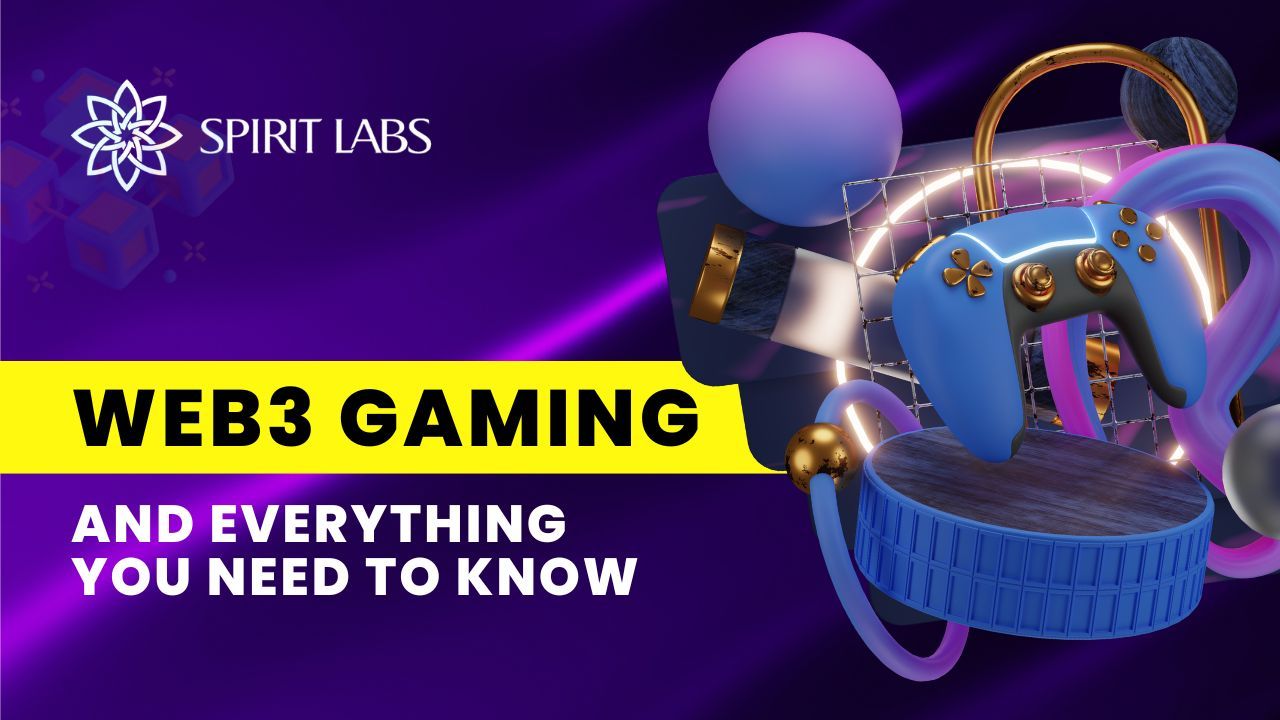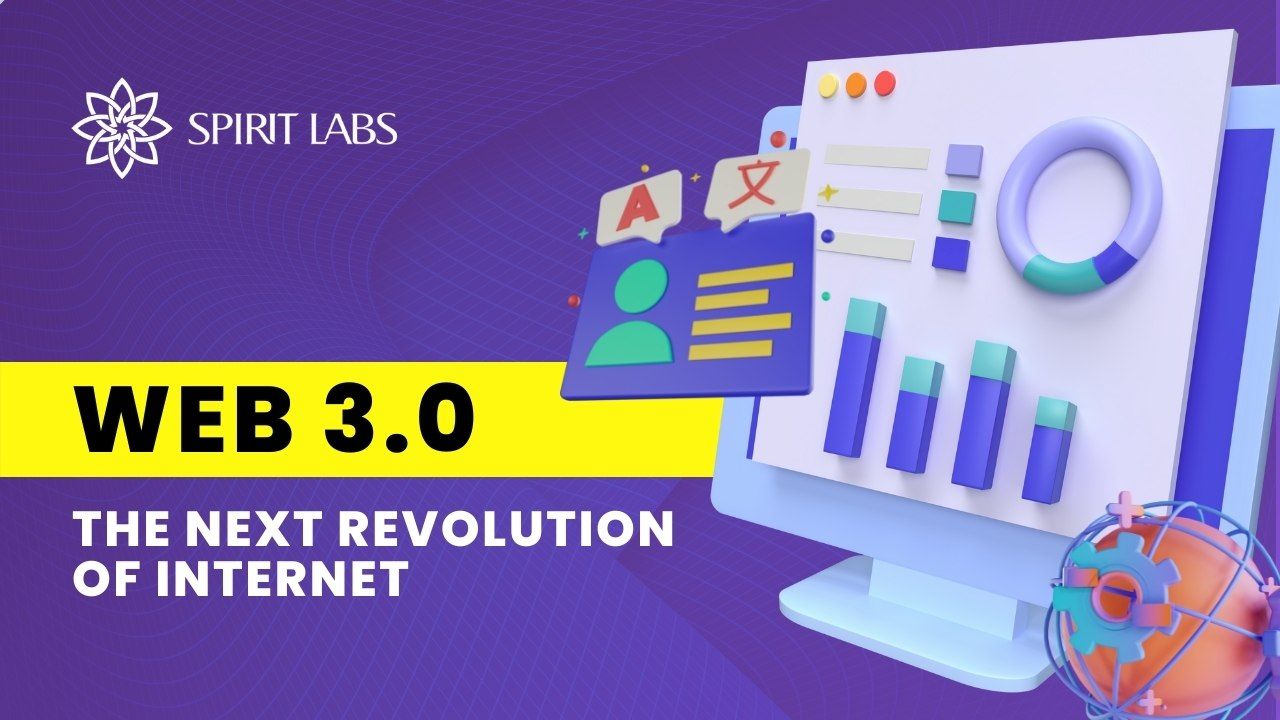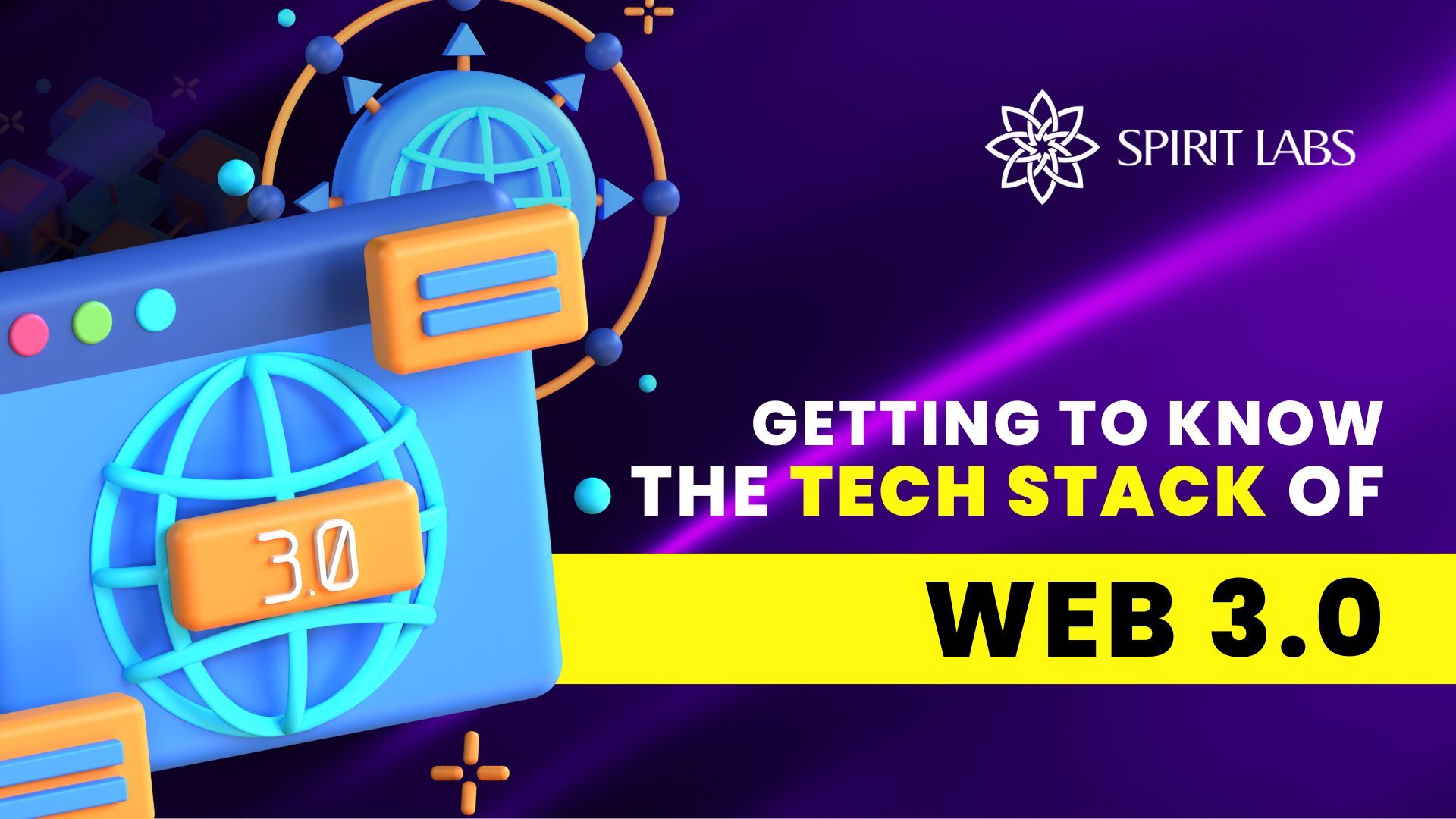
Getting to know the Tech Stack of Web 3.0
Web 3.0 definitely changed the game of how users create content and control their data on the Internet without the third party. All the decentralized applications can be easily connected with a single identity under high security and ownership. This is a great opportunity for your business to start adopting this technology integration to join in the ecosystem of interoperability, and to catch a trend in the era of Web 3 transformation.
Web 3.0 blockchain market size is predicted to reach $33.53 billion by 2030 with a compound annual growth rate (CAGR) of 44.9% from 2022 to 2030, according to the report of Global Web 3.0 Blockchain Market Size Report, 2022-2030 by Grand View Research, Inc. The major factors which contribute to the market growth are the explosive ability of Web3 to provide data privacy through decentralized identity and other technological advancements in the Internet environment. The rapid increase in the popularity of digital assets such as cryptocurrencies and the growing usage of connected applications, along with upgraded transaction processes, are further supporting the improvement of Web3 blockchain technology in the tech industry.
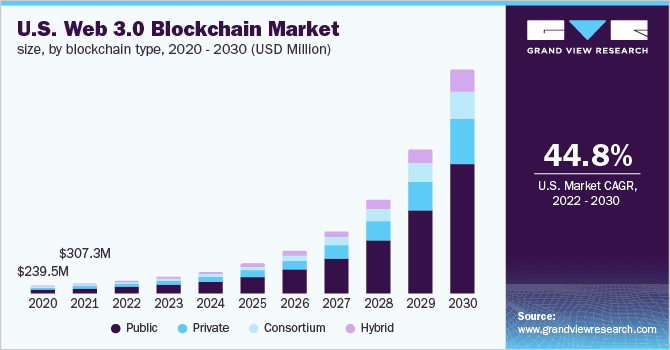
Source: Global Web 3.0 Blockchain Market Size Report, 2022-2030 - Grand View Research
To increase user scalability and flexibility, many players are concentrating on creating Web 3.0 platforms, because web 3.0 is a better internet in which applications and websites are in charge of processing data in a human-like manner. During the forecast period, these blockchain products are anticipated to generate attractive growth possibilities for the sector.
The industry's growth is also projected to be fueled by the increasing adoption of Web 3.0 cryptocurrencies to automate transactions over the internet. Simultaneously, Web 3.0 cryptocurrency trading provides better advantages including decentralization and expansion potential. Additionally, it does not need approval from higher authorities, which is an added benefit. To entice new participants and advance, nations are concentrating on legalizing cryptocurrencies.
North America dominated the market in 2021 and accounted for a global revenue share of over 37.0%. The rising acceptance of Web 3.0 in numerous operating systems is a driving factor for the growth of the regional market. At the same time, the presence of major blockchain solution providers such as Web3 Foundation and Helium Systems Inc. in the region is also attributed to the regional growth.
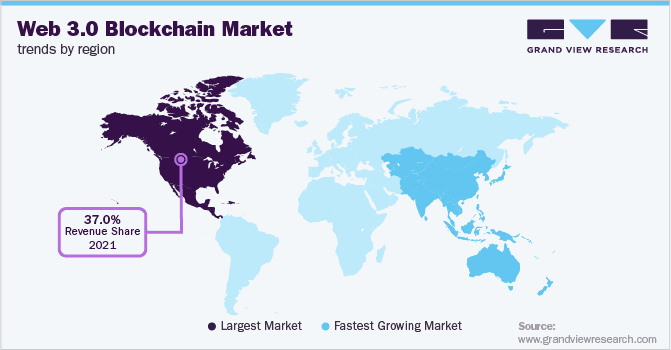
Source: Global Web 3.0 Blockchain Market Size Report, 2022-2030 - Grand View Research
The Asia Pacific is projected to emerge as the fastest-growing market during the forecast period. The rapid adoption of digitization using Web 3.0 among banking and finance companies, followed by retail and e-commerce industries, is the major factor driving the growth of the Asia Pacific region.
Web3 is generally considered to be a trustless, permissionless, and decentralized internet with the base of blockchain technology. This brings benefits and competitive advantages to your business product when the world is shifting its focus to data privacy and interoperability between apps.
Before jumping into any digital transformation, understanding how the underlying technology components work is essential to clarify the technological differences and encourage the process of making business decisions.
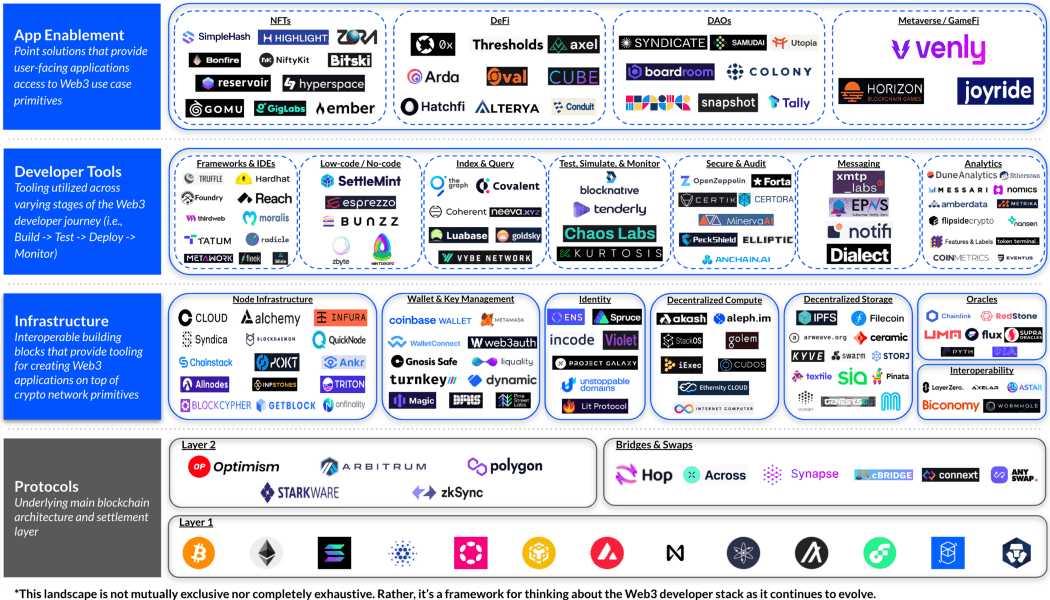
Source: A simple guide to the Web3 stack - Coinbase
Let's start from the bottom up. Protocol is the underlying architecture which is the first blockchain foundation to build on. There are a wide variety of layer 1 with smart contracts platforms such as Ethereum and Solana. To alleviate its capacity limitations, multiple layer 2 scaling protocols can be built on top of Ethereum. However, developers may build layer 2 protocol on other platforms like Optimism of Arbitrum.
With the rise of many layer 1 and layer 2 networks came the need to bridge value between them. Enter cross-chain bridges that serve as highways that let users move value from one chain to another. For applications that need to port value from one chain to another, developers will want to leverage cross-chain bridges like Hop or Synapse.
Once these decisions are made, your development team can start to incorporate building blocks that make user applications possible.
The layer of infrastructure is laid on top of the protocol foundation. It is in charge of composing interoperable blocks which are responsible for doing a specific task and able to combine to create cross-platform applications, from smart contract auditing software, data storage, communication tools, data analytics platforms, and more.
- Node infrastructure: Nodes form the blockchain infrastructure for interaction between an app and a blockchain. It is capable of reading the current state of the blockchain and constantly exchanging the latest blockchain data with each other so all nodes stay up to date. Coinbase Cloud, Infura, and Alchemy are node infrastructure providers with the support of setting up and managing blockchain nodes.
- Wallet & Key Management: Blockchain wallets provide users private keys to generate transactions within Web 3.0 applications, as well as enable your developers to create connectivity between blockchain wallets and customer-facing applications.
- Identity: Protocols like ENS serve as a user’s identity across applications, while Spruce provides frameworks and toolkits that developers can use to verify user credentials to authenticate actions on Ethereum. Therefore, developers can enable users to sign into apps using their ENS accounts by using the Spruce ID toolkit.
- Decentralized computing: Computing resources provide processing power that applications rely on to carry out computational tasks. Decentralized computing is a shift to community-owned networks where compute resources are shared cost-effectively and without restriction.
- Decentralized storage: It is expensive to store all of the data related to a specific web3 app directly on blockchain nodes. Web3 developers can use peer-to-peer data storage protocols like IPFS, Arweave, and Ceramic Network for some data instead of storing it on a centralized database. For instance, while the Web3 blogging platform Mirror is built on Ethereum, Arweave is used to store its blog content.
- Oracles: For a typical Ethereum application, the blockchain stores transaction history, balances, smart contracts, and other variables. However, it is unable to store or interact with data from outside sources. Oracles that link blockchains to both on-chain and off-chain data sources can help with this.
- Interoperability: Many different blockchains exist but few have the ability to exchange value and make use of information cross-chain. Interoperability protocols are necessary to build apps that are portable and able to communicate with different blockchains.
This layer is crucial to establish the P2P network and manage the flow of data.
- Frameworks & IDEs: Frameworks consist of libraries of code that have been created that make development easier. Developers can leverage Web3 frameworks like Truffle, Moralis, Tatum, and ThirdWeb with existing code so they do not have to build everything from scratch, as well as test and deploy applications. Integrated development environments (IDEs) like Foundry and HardHat combine standard source code editors with automation and debugging tools into a single, intuitive interface.
- Low-code/No-code: These platforms make it possible to quickly design and deploy user-facing applications using drag-and-drop user interfaces. To save Web 3.0 developers from having to create the wheel from scratch, companies like Settlemint offer developers smart contract templates for NFTs.
- Index & Query: Data indexers help people locate and access specific data within an underlying database. To assist your development team in retrieving, processing, and querying blockchain data, decentralized indexing services are starting to emerge in Web 3.
- Test, Simulate & Monitor: Before they are made public, Web 3 applications should be tested and emulated. The behavior of smart contracts and transactions can be predicted using a variety of tools provided by businesses like Tenderly and Kurtosis, as well as tools for troubleshooting any problems.
- Security & Audit: These platforms assist developers in implementing security and audit best practices for their applications in light of the potential for smart contract exploits. For developers to reduce potential security risks and vulnerabilities, OpenZeppelin, Forta, Certik, and Certora all offer a range of services, frameworks, and monitoring tools.
- Messaging: Web3 apps often involve sending various communications to end users, like when a crypto wallet may want to push a user alerts regarding transaction confirmations. Secure messaging protocols and decentralized communication networks are built to drive user engagement and power these notifications within Web3 applications.
- Analytics: There’s a host of platforms and services that explore, analyze, extract, and visual blockchain data. A variety of APIs are offered with the capabilities to build data visualization features and share data insights on various crypto projects within web3 apps.
The top layer of the Web 3 tech stack is protocol-extensible with user-interfaces such as Metamask, Parity, and MyCrypto that serve as the entry point for all manner of Web3 activities.
The infrastructure needed to run the Web3 components is not provided by a standard browser like Chrome. As a result, the layer provides access to the dApps. The public can interact with the decentralized network easily thanks to the user-friendly frontend. The layer is also necessary for combining various elements, such as Data and Analytics, NFT, and DeFi, to create various dApp categories.
The first thing you'll need is a wallet because that's where most Web3 applications start. Users can exchange their fiat currency for cryptocurrency to get started by using fiat onramps like Moonpay, Wyre, or exchanges like Coinbase. When users have some cryptocurrency in their wallet, they can go to an aggregator like DappRadar to browse and connect to a variety of Web3 applications.
Let’s think of the Web3 Tech Stack as a continuously evolving framework. The protocols, infrastructure, user applications, and access points named above make up the nascent. The power of Web3 lies in its modularity and interoperability which means that there are endless ways that the above stack can be combined to create new use cases and world-changing applications.
If you’re interested in building out the Web3 tech stack or concerned about adopting decentralized technology to your product, we would love to hear from you!
Let's talk business: https://spiritlabs.co/contact-us
REFERENCES:
- Blog: Distinctive Components of the Web 3
- Blog: A simple guide to the Web3 stack
- Blog: Welcome to the Web3 Technology Stack
- Blog: Web3: in a nutshell
- Article: Global Web 3.0 Market Size Expected to Reach $81 Billion by 2030 as Branding & Marketing Needs Increase
- Article: Web 3.0 Market Size, Share, Trends, By Type, Blockchain Type (Public, Private, Hybrid, and Others), By Organization Size (Small and Medium-Sized Enterprises, Large Enterprises), By Application, By Vertical, and By Region Forecast to 2030
- Article: Web 3.0 Blockchain Market to Hit $33.53 Billion by 2030 - Grand View Research, Inc.
